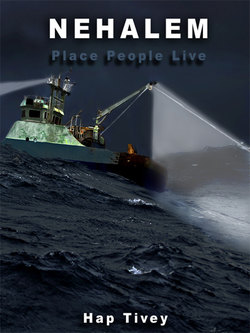Читать книгу Nehalem (Place People Live) - Hap Tivey - Страница 2
ОглавлениеNehalem
(Place People Live)
A Novel
Hap Tivey
Copyright 2011 by Hap Tivey
All rights reserved, including the right of reproduction
in whole or in part in any form.
Published in eBook format by eBookIt.com
ISBN-13: 978-1-4566-0252-9
Design and Cover by Liminal Light
Liminal Light Press
Suite 11R
1 Union Square South
New York, New York 10003
This book is solely a work of fiction. Characters, names, places, dates, and incidents are either products of the author’s imagination, or are used fictitiously. Maps have been redrawn, times changed and facts altered. Anyone wishing to find an accurate guide to surfing, hiking or fishing in these pages may be sorely disappointed. Any resemblance to actual locations, events, or persons, alive or dead, is entirely coincidental.
Foreword
To glimpse the imminent possibility of wild salmon extinction, one might look at a single historically abundant species. At one time, British Columbia’s Frazer River was second only to the Columbia in the scale and magnitude of its fishery and remains the last of the enormous river drainages that survive essentially free of hydraulic impoundments that strangle the migration of salmon. It also drains some of the greatest wilderness regions remaining in North America. In spite of that, 2007 saw the number of Sockeye salmon reduced to a count of approximately ten million. Before that number became a carefully monitored statistic used for wildlife management, the Sockeye population may have been ten to twenty times as large. The Pacific Salmon Commission, an organization created by joint treaty between Canada and the United States in 1985, estimates the number of Sockeye salmon returning in 2009 will be reduced to approximately 1.3 million. That number represents less than one half of the returning population predicted by 2008 figures. These numbers represent population declines greater than fifty percent each year.
Unlike Chinook and Coho, which are more highly prized and aggressively fished, Sockeye have traditionally maintained healthy wild populations. After the Columbia died, the Sacramento River Basin hosted the largest Chinook salmon run on the continental U.S. coast and a far more chilling statistic emerged this year from that watershed. In 2002, the Pacific Fisheries Management Council estimated the fall run of wild Sacramento Chinook at 775,000. An estimated 6,000 wild salmon are expected to return in 2009 – despite the fact that all commercial Chinook fishing (within the U.S. fleet) has been banned.
Virtually all commercial salmon fishing along the west coast of the continental US has been reduced to a tiny fraction of what it was four decades ago and this year, for the first time, major drainages have been closed to legitimate hard working fishermen, who are now subsidized to stay out of the water and wait. Presumably we are waiting for the return of wild fish to repopulate the rivers, but wild fish have inexplicably vanished and hatchery bred fish only know the route back to their hatcheries. Furthermore, hatchery stock’s ability to reproduce declines by approximately forty per cent with each inbred generation. The great North American breeding drainages are rapidly becoming barren. The fact that commercially farmed and hatchery bred salmon appear readily available for purchase disguises the fact that the sustainable populations of wild fish are spiraling uncontrollably toward extinction.
Numerous explanations for the devastating declines exist, including dams, clear-cut logging’s destruction of watershed, unregulated international fishing techniques, pesticide pollution, diseases and parasites broadcast into wild populations from fish farms and most recently, temperature change as a result of global climate shifts. Most of these receive some kind of publicity and it is most probable that all of them contribute, but addressing them in a factual scientific manner requires a different kind of book.
Nehalem is simply a story, which hopefully may raise some concern about our culture’s willingness to embrace extinction justified by commercial profit. It was inspired by people who enriched my life with their adventures, many of which I shared to some degree. I especially appreciate the time and effort my friends donated to help me fish, surf, and kayak along the magnificent Pacific Coast’s beaches and archipelagos.
